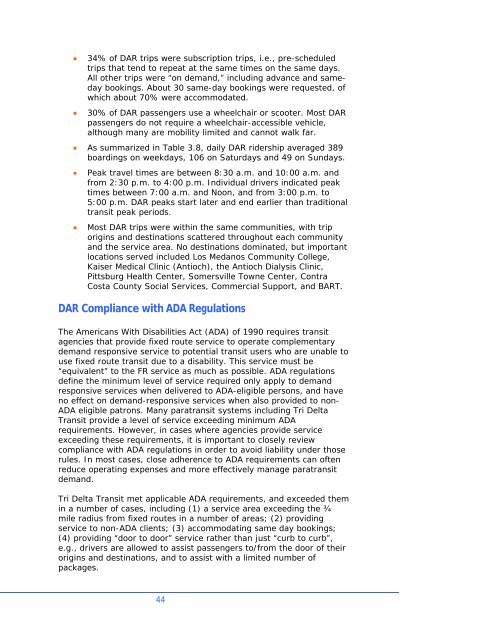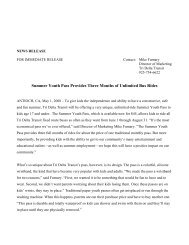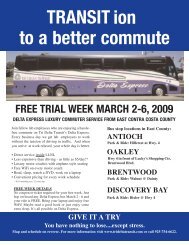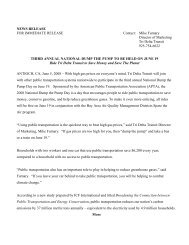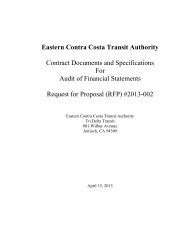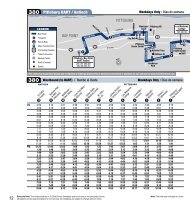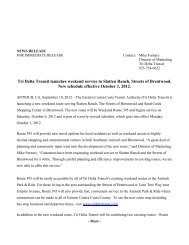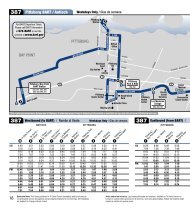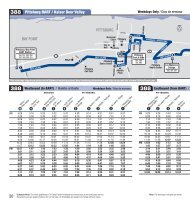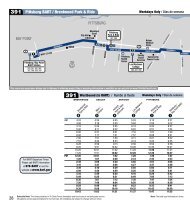to view Short Range Transit Plan FY 2007/2008 - Tri Delta Transit
to view Short Range Transit Plan FY 2007/2008 - Tri Delta Transit
to view Short Range Transit Plan FY 2007/2008 - Tri Delta Transit
Create successful ePaper yourself
Turn your PDF publications into a flip-book with our unique Google optimized e-Paper software.
• 34% of DAR trips were subscription trips, i.e., pre-scheduledtrips that tend <strong>to</strong> repeat at the same times on the same days.All other trips were “on demand,” including advance and samedaybookings. About 30 same-day bookings were requested, ofwhich about 70% were accommodated.• 30% of DAR passengers use a wheelchair or scooter. Most DARpassengers do not require a wheelchair-accessible vehicle,although many are mobility limited and cannot walk far.• As summarized in Table 3.8, daily DAR ridership averaged 389boardings on weekdays, 106 on Saturdays and 49 on Sundays.• Peak travel times are between 8:30 a.m. and 10:00 a.m. andfrom 2:30 p.m. <strong>to</strong> 4:00 p.m. Individual drivers indicated peaktimes between 7:00 a.m. and Noon, and from 3:00 p.m. <strong>to</strong>5:00 p.m. DAR peaks start later and end earlier than traditionaltransit peak periods.• Most DAR trips were within the same communities, with triporigins and destinations scattered throughout each communityand the service area. No destinations dominated, but importantlocations served included Los Medanos Community College,Kaiser Medical Clinic (Antioch), the Antioch Dialysis Clinic,Pittsburg Health Center, Somersville Towne Center, ContraCosta County Social Services, Commercial Support, and BART.DAR Compliance with ADA RegulationsThe Americans With Disabilities Act (ADA) of 1990 requires transitagencies that provide fixed route service <strong>to</strong> operate complementarydemand responsive service <strong>to</strong> potential transit users who are unable <strong>to</strong>use fixed route transit due <strong>to</strong> a disability. This service must be“equivalent” <strong>to</strong> the FR service as much as possible. ADA regulationsdefine the minimum level of service required only apply <strong>to</strong> demandresponsive services when delivered <strong>to</strong> ADA-eligible persons, and haveno effect on demand-responsive services when also provided <strong>to</strong> non-ADA eligible patrons. Many paratransit systems including <strong>Tri</strong> <strong>Delta</strong><strong>Transit</strong> provide a level of service exceeding minimum ADArequirements. However, in cases where agencies provide serviceexceeding these requirements, it is important <strong>to</strong> closely re<strong>view</strong>compliance with ADA regulations in order <strong>to</strong> avoid liability under thoserules. In most cases, close adherence <strong>to</strong> ADA requirements can oftenreduce operating expenses and more effectively manage paratransitdemand.<strong>Tri</strong> <strong>Delta</strong> <strong>Transit</strong> met applicable ADA requirements, and exceeded themin a number of cases, including (1) a service area exceeding the ¾mile radius from fixed routes in a number of areas; (2) providingservice <strong>to</strong> non-ADA clients; (3) accommodating same day bookings;(4) providing “door <strong>to</strong> door” service rather than just “curb <strong>to</strong> curb”,e.g., drivers are allowed <strong>to</strong> assist passengers <strong>to</strong>/from the door of theirorigins and destinations, and <strong>to</strong> assist with a limited number ofpackages.44


